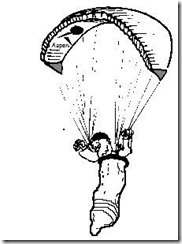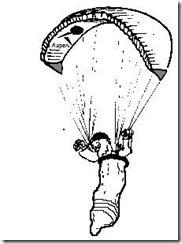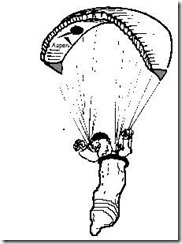Given the state of the weather, here’s a timely reminder about why flying with wet, or even damp, paragliders is a very bad idea.
PSC Safety Bulletin
By Brian Stewart on September 10, 2019 14:41
September 2019 Changing winds - revisited
The forecast was for light winds, starting in the East and veering right around the compass through SE, S, SW to West by mid-afternoon, so where else would you go but Parlick, with an eye on the Totridge run before the wind swung too far. It turned out pretty spot on to begin with and the East bowl was fairly busy, without too much height to play with. Murph showed how it’s done with a tenacious trip across the washing machine early on to complete the run. Later as the wind went further South-East more attempted the trip and at least 3 managed it cleanly without a touch and go.
Coming back into the bowl, it would have been easy to head back to the East face take off, but for the warning signs:
· The forecast direction change
· My instrument told me the wind was SSW (I don’t trust the XCSoar wind calculation too strongly, it takes a lot of consistent circling before it makes up its mind)
· The glider field windsock
· A PG not having a good time near the crags
GJ and I headed on a direct line to the showground and enjoyed a very lifty ride; others shot up 3000’. Something was going on. 5 minutes after landing in Chipping, still more or less into a Southerly wind, the trees around us started thrashing violently from the West as the sea breeze (?) switched on. Meanwhile in the landing field there were backwards landings and blow-backs into the wrong field.
As always, awareness of the conditions is vital. Keep asking yourself what the wind is doing; how it compares with what you expected. If a sea breeze arrives at Parlick, it can catch anyone out, especially after a long period of fairly constant, benign wind speeds and directions. The sudden appearance of massive lift suggests a convergence as the two winds met – another warning sign that things are about to change.
Tight lines.
Brian
Safety Notes August
By Brian Stewart on August 5, 2019 18:40
PSC Safety Bulletin
August 2019 BOLO
BOLO: Be On Look Out for . . . apparently I read too many crime thrillers. Earlier this week a few of us encountered an endangered species on Parlick East. These creatures aren’t threatened by the environment, or global warming, or country leaders with mad hair; no, they are undone by their own actions. This one displayed many of the common features of the hapless creatures: standing off to one side, no eye-contact with anyone else, holding bits of kit in his hand wondering what it did – you know the look. No helmet, a climbing harness and just a T-shirt completed the picture.
I cautiously approached, ready to run and hide behind Paul if I aroused the threat response for which these specimens are renowned. This one turned out to be most polite and courteous, phew! Some careful questioning produced the following: Where did you get the wing? Ebay. What is it? No idea. Age? Dunno. Size? Does it matter? BHPA? What’s that? Lessons? Watched YouTube.
I had a long chat with him, as did several others at different times during the afternoon. To be fair to him, he seemed to be a pleasant, decent bloke who would be good company over a pint in the Sun. He listened to what we had to say about the benefits of learning properly, BHPA insurance etc. but still insisted he was going to take off. We all advised him not to, explained that we could not offer any guidance without putting ourselves at risk, legally, and left him to it.
Luckily for him, he never even looked like getting launched, despite his claim to have spent ‘every day’ ground handling and flying in Tenerife. The wing must have been 15 years old, probably so far out of trim as to be unflyable. Speaking to him later, it seemed like our advice had penetrated, and he would ‘think about’ what we said.
Sadly, this is becoming a common occurrence all over the place. A recent article in Skywings spelled out the pitfalls of a lack of insurance, so no point in going over them here – I am preaching to the converted after all. (Yes?). I hope the combined effect of several pilots speaking to him in reasonable tones about his unreasonable actions might just have sowed some seeds of doubt in his mind. Perhaps we can all keep a lookout for these unfortunate people, and with the right approach keep them from harm. As well as keeping ourselves safe.
Tight lines.
Brian
PSC Safety Bulletin July 2019
By Brian Stewart on July 19, 2019 16:31
Landing Direction
We all know which way to land, don’t we? Into wind, of course. I got a timely reminder recently of how important it is to keep monitoring the wind direction during a flight. The LCC was on Blease Fell, forecast was a light SSW. Very light at first, which had me and Jim thinking triangles as we weren’t in the comp, but after trying to penetrate into wind, that clearly wasn’t going to happen without switching to a Zeno. As the speed picked up, there were reports of pilots getting blown into awkward situations, and some elected to abort the task early and land in the football field.
I left the summit of Blencathra at base, well above any turbulence and there was a great looking cloudstreet over Carrock and on towards Carlisle, confirming the forecast direction veering to SW later. The blue sky showed a sea breeze pushing in from the west, over the Solway Firth, so I was dog-legging away from the coast, eventually turning east to follow the A69 Carlisle-Newcastle road, belting along at 60 km/hr. All good, and all so predictable.
Serious turbulence and a big change in the thermal consistency showed something had changed, and I opted to land at Low Row where I had a chance of hitching a lift. When I set up for a landing out, I build a picture in my head of the terrain, the wind direction and strength, trying to visualise what I might encounter and planning the best approach. Fortunately, I had plenty of height: after my first circle above my chosen field, I had to do another one as I couldn’t reconcile what I could see happening, and what my instruments told me, with my mental image. The wind was 180 degrees wrong – blowing from the East, and strong! No drama, plenty of room to adjust my approach, but I could have had a nasty surprise trying to land into the wind I thought was there. The presence of layers of wind in opposite directions also explains the violent turbulence earlier, but I saw nothing in any forecast predicting an easterly wind in that location. So the moral of the story is to always keep monitoring the conditions, especially when moving into different terrain.
Tight lines.
Brian


